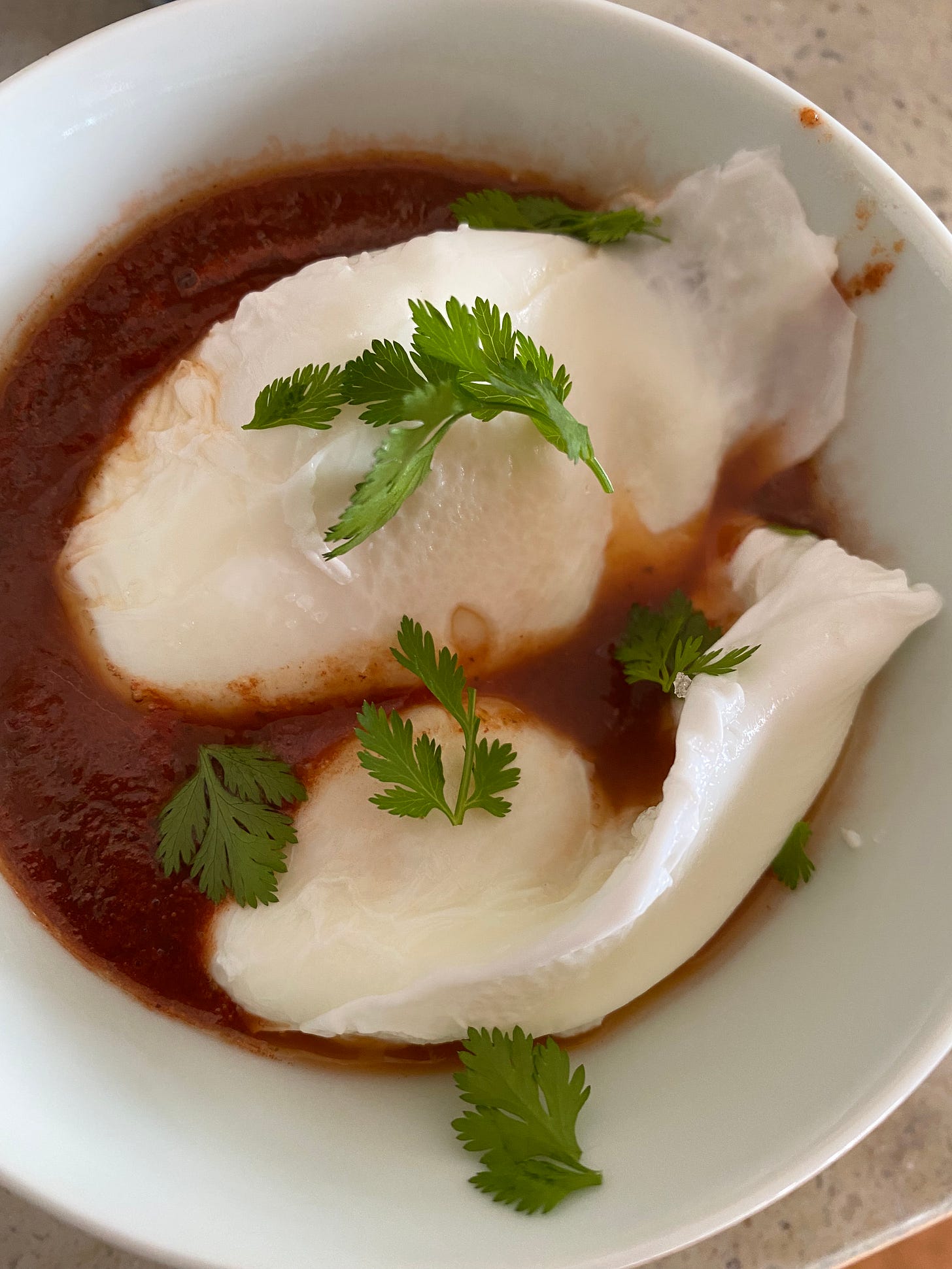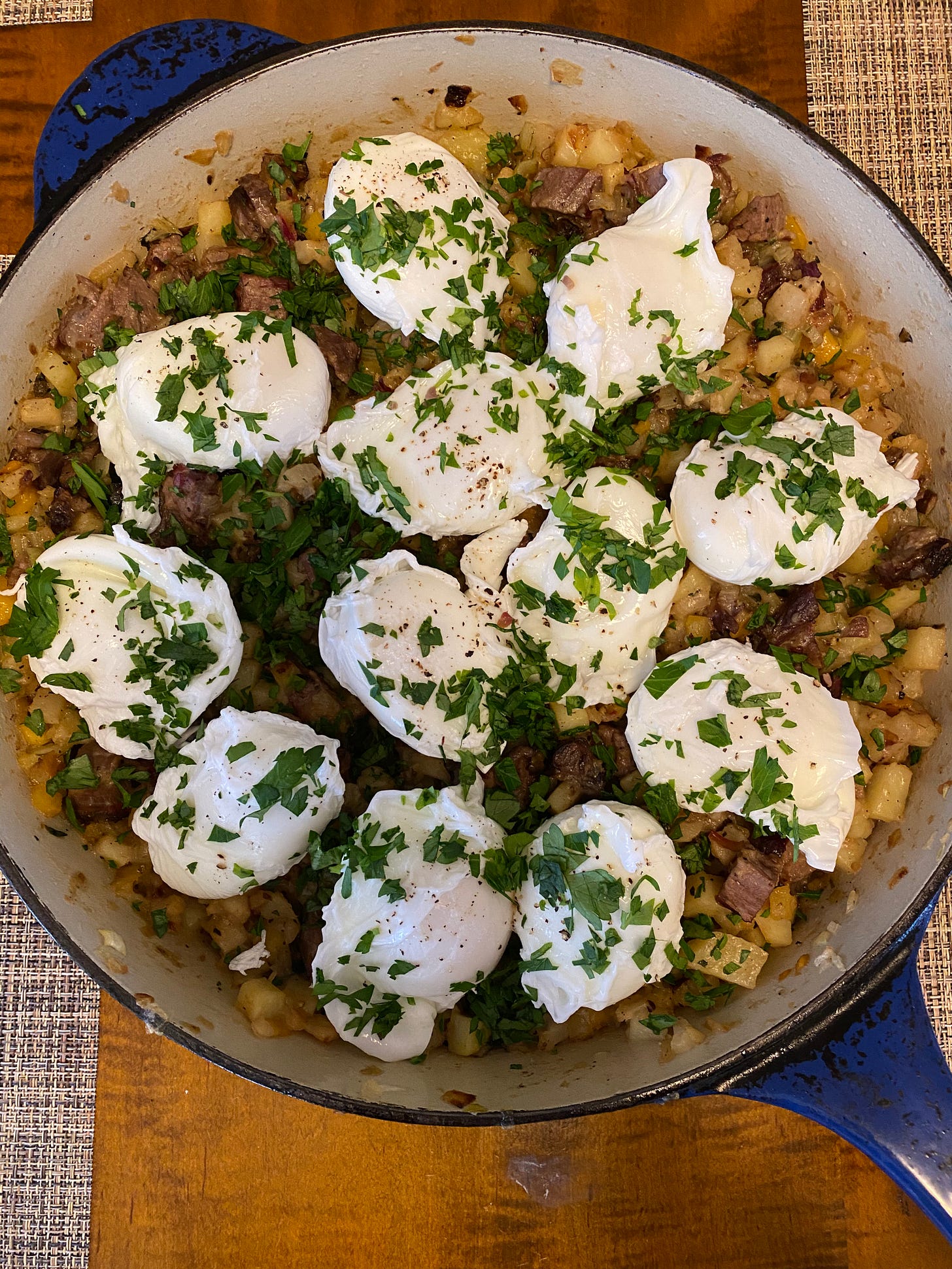It’s been a busy week and today’s newsletter was a delayed a few hours. (I like to send it Wednesday mornings.) But here’s Issue #12 in your inbox. Hope you like it. If you do, put an egg on it. No, I mean…please think about sharing it with friends and family who like to cook. Special thanks to all paid subscribers who are supporting the efforts of this independent writer and the spirit of independent writing in general. — Mitchell
My first restaurant job was as a line cook in a restaurant called Rhodes in Toronto. It was the summer between my freshman and sophomore years of hotel school and I needed practical credits from working in the hospitality industry. I had already been cooking at home for years. I worked on the counter in a butcher shop in high school and catered events with my sister. I started a company that made chicken soup for that same butcher shop (they provided the bones). But I’d never before experienced the heat of the line in a professional kitchen.
Rhodes was a trendy bistro of the era (1980s): big white plates, a combination of classic dishes, like steak au poivre, and contemporary ones for the time, like Asian chicken salad with creamy sesame dressing. We used a lot of raspberry vinegar. We grilled swordfish steaks and served them with fresh melon salsa. We had an excellent Caesar salad and a burger that came with delicious twice-fried French fries we cut in house from fresh Prince Edward Island potatoes. Most celebrities in town for the city’s new film festival would drop into Rhodes because the dining room was dark and the clientele discreet. This was before Toronto became an outpost of Hollywood teaming with movie stars. Brunch was very popular. I started on the grill and fry station during weekday dinner service—it was a four-cook line—and I worked my way up to head line cook at weekend brunch. Truth be told, by the time I arrived, the restaurant’s sparkle had begun to fade, which is probably why they hired such an inexperienced cook.

Every Saturday and Sunday morning I had to poach about 100 eggs—to serve on corned-beef hash, salade frisée-lardons, and of course, eggs benedict. I poached 50 at a time in a giant rondelle with nothing but a lot of water, a little vinegar, some salt, and a slotted spoon. Although the pot could have held more, I came to settle on 50 because by the time I was finished cracking the 50th egg into the water—I divided the pot into quadrants and filled one quadrant at a time so I could keep track—the first ones were ready to come out.
Last weekend my friend Lonni was visiting us at the lakehouse and she happened to mention she loves poached eggs, but she has never successful made one, despite many attempts. She’s watched numerous YouTube videos and even purchased a few contraptions to help. But nothing seemed to work. I asked what she had done, and stopped her when she got to the topic of whirlpools. In my experience, all you really need is fresh eggs and the courage of your convictions. Whirlpools are unnecessary.
I continue to poach eggs pretty regularly, a couple as a garnish for weekday breakfast tartines for me and Nate, or a dozen to top a hash at a brunch for friends. I subscribe to the #putaneggonit school. Poached eggs make things better. My technique is simple, it produces consistent results, and it takes less than five minutes with minimal equipment. I showed Lonni how to do it, and then took some photos and a time lapse video for you. Good luck.
TECHNIQUE: How to Poach Eggs
Ingredients
Fresh eggs, cold from the fridge
White vinegar, just a capful
Pinch salt
Equipment
Small deep pot
Clean dishtowel or paper towels
Slotted spoon
Timer
Fill a pot with water about 2 1/2 inches deep. The size of the pot depends on how many eggs you are poaching. Most important is that it is deep enough so that when they eggs are dropped in, the white has time to congeal a little before it hits the bottom. To poach 2 eggs I use a small, deep, 1-quart pot.
To the water, add a capful of vinegar and a pinch of salt. The acid in the vinegar helps congeal the white. I hate when people add so much vinegar that you can taste it on the eggs—totally unnecessary. There’s a debate about whether the salt does anything, but I always add it, so that’s the side I take. Have a metal slotted spoon and a clean dishtowel folded into a square nearby.
Bring the water to a boil over high heat. Just when the water has started to boil, crack the eggs into the water. How you crack the eggs is key. You have to move quickly and definitively, with conviction. Crack the side of the egg on a hard surface. Get ready to separate the two halves of the shell. You need to do this over the water, and quickly so that the egg drops in all at once. Repeat with the second and subsequent eggs in rapid succession. Set a timer for 2 minutes 30 seconds.
Just as the water comes back up to a boil, lower the heat to keep it at a strong simmer. Egg-white foam will gather on top of the water. Don’t fret. This is the loose white that won’t cohere around the yolk. (Think of when you separate eggs, how most of the egg white falls off the yolk as a blob. This foam is made of the other white that streaks down the side of the shell. The older your eggs, the more loose white that will escape.) When you push the foam aside with your slotted spoon, you should see your eggs cooking below.
When the timer goes off, hold the clean towel in your non-dominant hand and the slotted spoon in the other. Use the spoon to carefully lift one of the eggs out of the water. If you are making more than 4 eggs, it’s good to remember which went in first (use geometry) so that you can take those out first, but it’s not a big deal if you can’t. They move around. Try to maneuver the spoon underwater so that the straggles of egg white don’t come with it. Be careful not to break the yolk. When the egg is out of the water, but still over the pot, use the edge of the spoon against the side of the pot to trim any stringy white. Carefully invert the egg from the spoon onto the clean towel to dry it off on both sides (as much vinegar-tasting poached eggs I hate whet poached eggs). Then invert the egg back onto whatever you are serving it on. Repeat.
Advanced Poaching
Poached eggs are best freshly made, but they can also be made in advance and chilled. Chilling allows you to more carefully trim the white to make them “perfect,” mind you I think some of the beauty of poached eggs is their variability. If you are making them in advance, poach your eggs for only 2 minutes 15 seconds. You want to preserve the liquidity of the yolk. (The white toughens when chilled.) When the timer goes off, lift the egg(s) from the cooking water directly into ice water to stop the cooking and chill. No need to wipe off on a towel…yet. Store in the fridge for up to one day. To reheat, bring a small pot of water to a simmer and, using a slotted spoon, slip the eggs from the cold water into the hot. Let warm up for about 30 seconds, then remove with a slotted spoon, dry on a clean towel as above, and serve.

A Note about Cleaning the Pot
Although I am confident about my egg poaching, I’m not so confident about cleaning my egg poaching pot. I think some sort of chemical reaction must occur between the egg white, the acid, and the stainless steel that produces a kind of cement around the edge of the water. With some heavy scrubbing you can get it off. But it isn’t easy, and you can end up scratching the surface of your pot pretty severely. I’ve tried poaching in pots with different surfaces, such as aluminum, enamel, and nonstick. But there always seems to be adherence. If anyone has a solution to this, I’m all ears.
Final Memories about Brunch Egg Cookery
While I managed to master poached eggs at Rhodes, I never quite figured out how to flip an over-easy egg without destroying it. (I’m a good pancake flipper, mind you.) During brunch, when an order came in for eggs over easy, I had to call the sous chef, Cassie, to come up from her office to make it. Cassie had worked as a short cook in a diner and I never saw her break a yolk. After once nearly coming to tears under the pressure of orders flying out of the printer while I hovered over the stove throwing out couplets of broken eggs one after the other, we implemented a new rule: If Cassie was away, brunch dishes only came with eggs sunnyside up, scrambled or poached. (I’m not kidding.)





